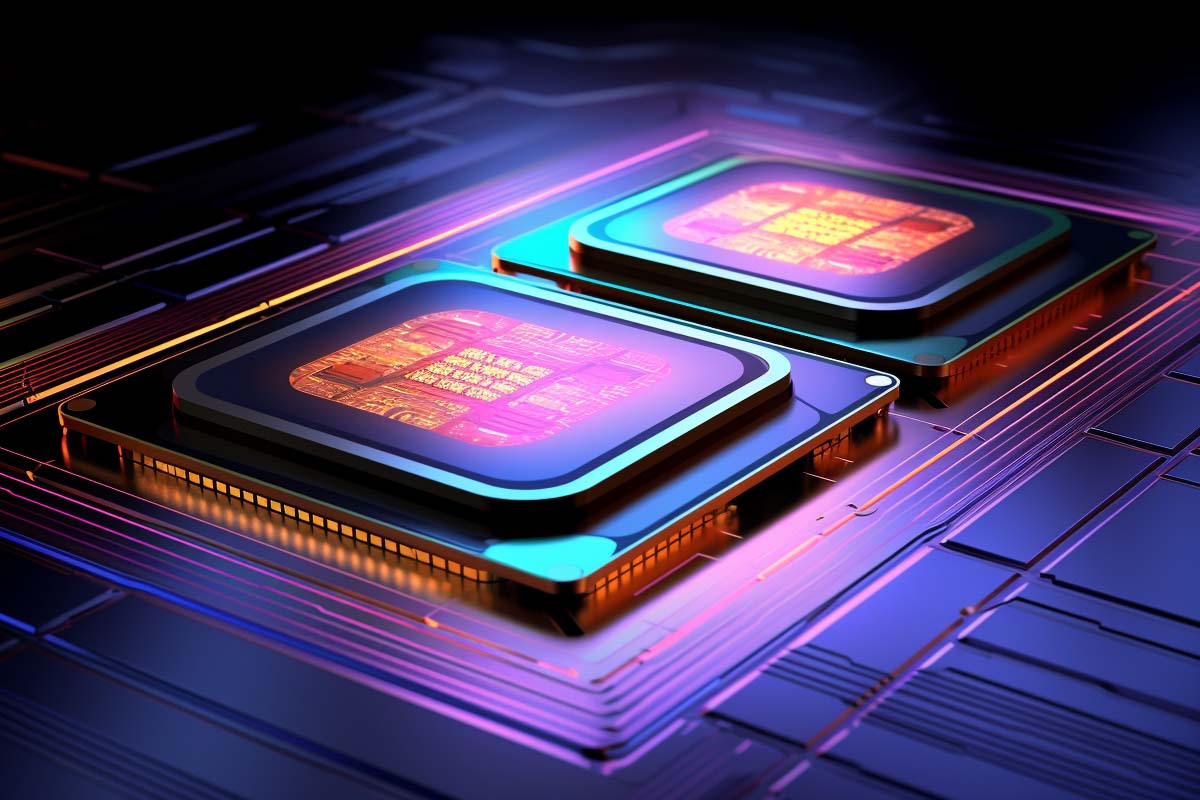What Is Access Control
Access Control is a security technique used to regulate who or what can view or use resources in a computing environment. It is a fundamental concept in security that minimizes

Multiprocessor CPUs, often known as multi-CPU architecture or dual-processor systems, incorporate two or more separate CPUs installed within the same computer, typically on the same motherboard or connected via a high-speed bus system. These CPUs, functioning as a CPU cluster, operate independently but are designed to work in tandem, sharing the same system resources such as memory (RAM) and I/O devices, requiring robust mechanisms for memory access management and data coherence.
Characteristics:

View our comprehensive training series covering all the key elements and certifications needed to successfully excel in an IT User Support Specialist job role.
A multicore CPU, which can range from dual-core to octa-core and beyond, encapsulates multiple execution cores on a single processor chip, enabling parallel data processing and thread-level parallelism (TLP). This design significantly enhances computational speed and efficiency, particularly for parallelizable tasks, while ensuring energy efficiency by sharing the same chip and power supply.
Characteristics:
Ready to kickstart your IT career but don’t know where to begin? Our ITF+ course is your perfect starting point! Master the essential IT skills you need to shine in the tech world. From hardware and software to programming and security, we’ve got it all covered. This comprehensive course is designed to help you ace the CompTIA FC0-U61 IT Fundamentals (ITF+) exam with flying colors.
The choice between multicore and multiprocessor systems often depends on the specific requirements, workloads, and operational contexts. Below are a few scenarios that illustrate where one might be preferred over the other:
In conclusion, while multicore CPUs are well-suited for energy efficiency, cost-effectiveness, and handling of general-purpose tasks, multiprocessor systems excel in environments that demand high computational power, scalability, and efficient parallel processing capabilities. The choice should align with the specific computational demands, performance requirements, and operational constraints of the intended application.

Embark on an exciting IT journey with CompTIA IT Fundamentals (ITF+) training! Dive into the essentials of hardware, software, programming, and more. This foundational course is your gateway to the IT world, setting the stage for future certifications. Start building your IT career today!
The landscape of CPUs is diverse, with various offerings tailored to different needs, ranging from personal computing to high-performance servers. Below is an overview of several categories of CPUs, from consumer-level to high-end server processors, along with general insights into their speed and processing capabilities. It’s important to note that the performance of a CPU can depend on various factors including core count, clock speed, thermal design power (TDP), and the specific architecture. The information provided is a general guide and may not include the latest models as of your inquiry.
When evaluating CPUs, it’s important to consider not just the raw speed (GHz) but also the number of cores, the presence of technologies like hyper-threading or simultaneous multithreading, cache size, and how the CPU fits into the overall system architecture, including the motherboard and RAM compatibility. For the most accurate and up-to-date information, it’s recommended to refer to the manufacturer’s specifications and benchmarks from reputable sources.
When discussing CPUs, multiprocessor, and multicore options, it’s beneficial to be familiar with the following key terms and their definitions:
| Term | Definition |
|---|---|
| CPU (Central Processing Unit) | The primary component of a computer that performs most of the processing inside a computer. It interprets and executes instructions from the computer’s memory. |
| Core | An individual processing unit within a CPU. Modern CPUs can have multiple cores, allowing them to execute multiple processes simultaneously. |
| Multicore CPU | A single CPU that contains two or more cores, enabling it to perform multiple operations simultaneously and independently. |
| Multiprocessor System | A computer system with two or more separate CPUs (processors), which can work independently or together to process instructions. |
| Clock Speed | The speed at which a CPU can execute instructions, typically measured in gigahertz (GHz). Higher clock speeds can indicate faster processing, but efficiency also depends on architecture and other factors. |
| Thread | The smallest sequence of programmed instructions that can be managed independently by an operating system scheduler. Multithreading allows multiple threads to be executed concurrently by a CPU. |
| Cache | A smaller, faster type of memory inside the CPU that stores copies of the data from frequently used main memory locations. There are typically multiple levels of cache (L1, L2, and L3). |
| TDP (Thermal Design Power) | The maximum amount of heat generated by a computer chip or component (often the CPU) that the cooling system is designed to dissipate under any workload. |
| Hyper-Threading / SMT (Simultaneous Multithreading) | Intel’s proprietary technology (Hyper-Threading) and the general term (SMT) for the process where a single physical CPU core appears as two logical cores to the operating system, improving efficiency. |
| Overclocking | The practice of increasing the clock speed of a CPU beyond the manufacturer’s specifications to achieve higher performance, often requiring improved cooling solutions. |
| Socket | The physical interface on a motherboard that allows for the installation of a CPU. Different CPU models may require different socket types. |
| ECC Memory (Error-Correcting Code Memory) | A type of computer data storage that can detect and correct the most common kinds of internal data corruption, often used in servers and workstations for increased reliability. |
Understanding these terms will help facilitate a more informed and productive discussion about CPUs, multiprocessor, and multicore options.
Multicore systems have multiple processing cores within a single CPU chip, allowing them to perform multiple tasks simultaneously within one processor. In contrast, multiprocessor systems consist of two or more separate CPUs that can work independently or together, each having its own processing cores. Multicore systems are generally more energy-efficient and cost-effective, while multiprocessor systems offer higher performance and scalability but at a greater cost and complexity.
The number of cores in a CPU directly impacts its ability to perform parallel processing. More cores mean the CPU can handle more tasks simultaneously, which can significantly improve performance for multitasking and applications designed to take advantage of multiple cores. However, not all applications benefit equally from additional cores, and some are more dependent on single-core performance or clock speed.
Cache memory is a small, fast type of volatile computer memory that provides high-speed data storage for the CPU. It holds frequently accessed data and instructions so the CPU can access this information more quickly than if it had to retrieve it from the main memory (RAM). A larger cache can significantly improve system performance by reducing the time the CPU takes to access data and instructions.
Upgrading to a multicore CPU can improve performance, especially if your applications and workloads can utilize multiple cores. However, upgrading to a multiprocessor system typically involves more than just replacing the CPU—it may require a new motherboard and other components compatible with multiprocessor configurations. Additionally, not all software benefits from multiprocessor systems, so it’s essential to consider your specific needs and whether the software you use can take advantage of the additional processing power.
Overclocking a CPU can increase its performance by raising its operating frequency beyond the manufacturer’s specifications. However, it also increases power consumption and heat production, which can lead to stability issues or shorten the lifespan of the CPU if not managed properly with adequate cooling and voltage adjustments. It’s essential to understand the risks, have proper cooling solutions in place, and proceed cautiously if you choose to overclock your CPU. The benefits include improved performance in CPU-intensive tasks and potentially better gaming experiences, but it’s not without its risks and should be done by those who understand the process and are aware of the potential consequences.
Lorem ipsum dolor sit amet, consectetur adipiscing elit. Ut elit tellus, luctus nec ullamcorper mattis, pulvinar dapibus leo.
$49.99 Original price was: $49.99.$16.99Current price is: $16.99. / month with a 10-day free trial
Access Control is a security technique used to regulate who or what can view or use resources in a computing environment. It is a fundamental concept in security that minimizes
Active Directory (AD) is a directory service developed by Microsoft for Windows domain networks. It is included in most Windows Server operating systems as a set of processes and services.
Adaptive Security is a proactive approach to cybersecurity that anticipates and responds to evolving threats in real-time. Unlike traditional security measures that are often reactive and static, Adaptive Security continuously
Address Space Layout Randomization (ASLR) is a computer security technique used in operating systems to protect against buffer overflow attacks. By randomizing the locations where system and application executables are
An Advanced Persistent Threat (APT) refers to a prolonged and targeted cyberattack in which an unauthorized user gains access to a network and remains undetected for an extended period. Unlike
Agile Methodology is a project management and software development approach that emphasizes flexibility, customer collaboration, and the rapid delivery of workable software solutions. This methodology is built around the idea
Agile Software Craftsmanship is a methodology that combines the principles of Agile development with the ethos of software craftsmanship. This approach emphasizes the creation of high-quality software through iterative development,
Artificial Intelligence (AI) represents the branch of computer science that aims to create machines capable of intelligent behavior. At its core, AI is about designing algorithms and computational models that
An algorithm is a set of rules or instructions designed to perform a specific task or solve a problem. Algorithms are fundamental to the field of computer science, acting as
Algorithmic Game Theory is a discipline at the intersection of computer science, economics, and game theory that studies how computational resources can affect strategic interactions and decision-making processes. This field
Amazon Machine Image (AMI) serves as a foundational block in the vast ecosystem of Amazon Web Services (AWS), offering a pre-packaged operating system, application server, and applications required to launch
A NAND gate, one of the fundamental building blocks of digital electronics, stands as a testament to the power of logic synthesis and circuit design. Integral to the architecture of
ENDING THIS WEEKEND: Train for LIFE at our lowest price. Buy once and never have to pay for IT Training Again.

Get ready for the updated 220-1201 & 220-1202 exams with our brand-new CompTIA A+ training—designed to help you pass with confidence and start your IT career strong. Access this course and over 2,900 hours of expert-led IT training when you sign up for any of our All-Access Passes. Don’t miss out—enroll now and start learning today!